考虑上风扇形区长度和角度的城市地面粗糙度改进计算方法
IF 7.1
1区 工程技术
Q1 CONSTRUCTION & BUILDING TECHNOLOGY
引用次数: 0
摘要
大多数计算城市地面粗糙度的传统形态计量方法只考虑了均匀高度阵列。然而,鉴于实际城市区域中建筑物的复杂布置,传统方法已无法满足当前的需求。本文对不同阵列的粗糙度元素进行了风洞实验,以确定不同上风扇形下调查位置的平均风速剖面。实验结果表明,随着上风扇区的扩大,当上风扇区的长度 r 增至 750 米,上风扇区的角度 θ 达到 70° 时,上风扇区对平均风速剖面的影响逐渐减小。这个长度为 750 米、角度为 70° 的上风扇面被定义为最小上风扇面。超过这个临界值,r 和 θ 的额外变化不会对平均风速剖面产生显著影响。在风洞实验结果和现有形态测量方法的基础上,提出了一种计算城市地面粗糙度的改进方法,同时考虑了均匀高度阵列和实际城市区域。在计算均匀高度阵列的地面粗糙度时,证明了这种改进方法的有效性。在应用于实际城市区域时,当计算区域定义为最小上风扇区时,该方法可获得最佳结果。与传统的形态测量方法相比,改进后的方法具有显著优势,是确定城市地区地面粗糙度的一种新方法。本文章由计算机程序翻译,如有差异,请以英文原文为准。
An improved method for calculating urban ground roughness considering the length and angle of upwind sector
Most traditional morphometric methods to calculate urban ground roughness only considered uniform height arrays. However, given the complex arrangement of buildings in real urban districts, traditional methods are no longer sufficient to meet current demands. In this paper, wind tunnel experiments were conducted on roughness elements with diverse arrays to determine the mean wind speed profiles in the investigating position under distinct upwind sectors. The experiment results indicate that as the upwind sector expands, its influence on the mean wind speeds profile diminish as the length r of the upwind sector extends to 750 m and the angle θ of upwind sector reaches 70°. This upwind sector, 750 m in length and 70° in angle, is defined as the minimum upwind sector. Beyond this threshold, additional variations in r and θ do not significantly affect the mean wind speed profile. An improved method for calculating urban ground roughness, considering both uniform height arrays and real urban districts, is proposed based on the wind tunnel experiment results and existing morphometric methods. The efficacy of this improved method has been demonstrated in calculating ground roughness in uniform height arrays. When applied to real urban districts, the method yields optimal results when the calculation area is defined as the minimum upwind sector. Compared to traditional morphometric methods, the improved method offers significant advantages and a new approach to determining ground roughness in urban districts.
求助全文
通过发布文献求助,成功后即可免费获取论文全文。
去求助
来源期刊

Building and Environment
工程技术-工程:环境
CiteScore
12.50
自引率
23.00%
发文量
1130
审稿时长
27 days
期刊介绍:
Building and Environment, an international journal, is dedicated to publishing original research papers, comprehensive review articles, editorials, and short communications in the fields of building science, urban physics, and human interaction with the indoor and outdoor built environment. The journal emphasizes innovative technologies and knowledge verified through measurement and analysis. It covers environmental performance across various spatial scales, from cities and communities to buildings and systems, fostering collaborative, multi-disciplinary research with broader significance.
 求助内容:
求助内容: 应助结果提醒方式:
应助结果提醒方式:


